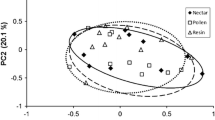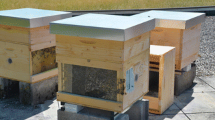Summary
For species ofLasioglossum, subgenusDialictus, the amount of seasonal body size variation of worker bees is correlated with indicators of the level of sociability attained by the species, such as queen longevity. Interspecific comparison of the amount of variation gives a simple measure of the level of sociality of the species. Different patterns of seasonal body size variation can be controlled by factors such as temperature and day length which are exogenous to the colony but in species with higher levels of sociality these patterns may be controlled endogenously.
Zusammenfassung
Die jahreszeitliche Variation der Körpergrösse der Arbeiterinnen vonLasioglossum (Dialictus)-Arten ist mit dem Grad der Sozialität (gesessen etwa an der Lebensdauer der Königinnen) korreliert, den die betreffenden Arten erreicht haben. Ein interspezifischer Vergleich der Grösse der Variation ergibt ein einfaches Mass der Sozialität der Arten. Verschiedene Muster der jahreszeitlichen Variation der Körpergrösse können unterschieden werden. In Arten mit niedriger Sozialität scheinen diese Muster von exogenen Faktoren, wie Temperatur und Tageslänge, kontrolliert zu werden, in sozial höheren Arten dagegen von endogenen (kolonieeigenen).
Similar content being viewed by others
Literature Cited
Batra (S. W. T.), 1966. — The life cycle and behavior of the primitively social bee,Lasioglossum zephyrum (Halictidae).Univ. Kansas Sci. Bull., 46, 359–423.
Breed (M. D.), 1975a. — The life cycle and behavior of a primitively social bee,Lasioglossum rohweri (Hymenoptera: Halictidae).J. Kansas Ent. Soc., 48, 64–80.—Breed (M. D.), 1975b. — The evolution of social behavior in primitively social bees; a multivariate analysis.Evolution (in press).
Kamm (D. R.), 1974. — Effects of temperature, day length, and number of adults on the sizes of cell and offspring in a primitively social bee (Hymenoptera: Halictidae).J. Kansas Ent. Soc., 47, 8–18.
Knerer (G.) andAtwood (C. E.), 1966. — Polymorphism in some Nearctic halictine bees.Science, 152, 1262–1263.
Knerer (G.) andPlateaux-Quénu (C.), 1966. — Sur le polymorphisme des femelles chez quelques Halictinae (Insectes Hyménoptères) paléarctiques.C. R. Acad. Sci. (Paris), 263, 1759–1761.
Michener (C. D.), 1966. — The bionomics of a primitively social bee,Lasioglossum versatum (Hymenoptera: Halictidae).J. Kansas Ent. Soc., 39, 193–217.
Michener (C. D.), 1974. — The social behavior of the bees.Harvard Univ. Press, édit., Cambridge, Ma., U.S.A., 404 p.
Michener (C. D.) andLange (R. B.), 1958. — Observations on the behavior of Brazilian halictid bees (Hym., Apoidea). V.Chloralictus.Ins. Soc., 5, 379–407.
Michener (C. D.) andWille (A.), 1961. — The bionomics of a primitively social bee,Lasioglossum inconspicuum.Univ. Kansas Sci. Bull., 42, 1123–1202.
Wille (A.) andOrozco (E.), 1970. — The life cycle and behavior of the social bee,Lasioglossum (Dialictus) umbripenne (Hymenoptera: Halictidae).Rev. Biol. Trop., 17, 199–245.
Author information
Authors and Affiliations
Additional information
Contribution number 1590 from the Department of Entomology, University of Kansas, Lawrence, Kansas 66045.
Rights and permissions
About this article
Cite this article
Breed, M.D. Sociality and seasonal size variation in Halictine bees. Ins. Soc 22, 375–379 (1975). https://doi.org/10.1007/BF02224112
Received:
Accepted:
Issue Date:
DOI: https://doi.org/10.1007/BF02224112




